Campania
Campania | |
|---|---|
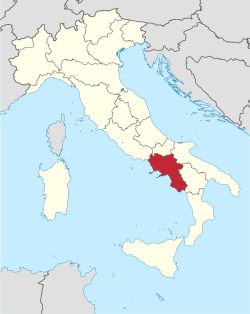 | |
| Coordinates:40°54′38″N14°55′14″E/ 40.91056°N 14.92056°E[1] | |
| Country | |
| Capital | Naples |
| Government | |
| • President | Vincenzo De Luca(PD) |
| • Legislature | Regional Council |
| Area | |
| • Total | 13,671 km2(5,278 sq mi) |
| Population (30 April 2023) | |
| • Total | 5,580,567 |
| • Density | 410/km2(1,100/sq mi) |
| Demonyms | |
| GDP | |
| • Total | €110.231 billion (2021) |
| Time zone | UTC+1(CET) |
| • Summer (DST) | UTC+2(CEST) |
| ISO 3166 code | IT-72 |
| HDI(2021) | 0.856[3] very high·19th of 21 |
| NUTS Region | ITF |
| Website | www |
Campania[a]is an administrativeregionofItaly;most of it is in the south-western portion of theItalian peninsula(with theTyrrhenian Seato its west), but it also includes the smallPhlegraean Islandsand the island ofCapri.The capital of the Campania region isNaples.[6]As of 2018, the region had a population of around 5,820,000 people, making it Italy's third most populous region,[7]and, with an area of 13,590 km2(5,247 sq mi), its most densely populated region. Based on itsGDP,Campania is also the most economically productive region insouthern Italyand the 7th most productive in the whole country.Naples' urban area, which is in Campania, is theeighth most populous in the European Union.[8]The region is home to 10 of the 58UNESCO sites in Italy,includingPompeiiandHerculaneum,theRoyal Palace of Caserta,theAmalfi Coast,the LongobardianChurch of Santa SofiainBeneventoand theHistoric Centre of Naples.In addition, Campania'sMount Vesuviusis part of theUNESCO World Network of Biosphere Reserves.[9]
The Campania's hinterland was inhabited from the beginning of the 1st millennium BC by theOsci,SamnitesandEtruscans,while between the 8th and 7th centuries BC its coastal areas were colonised by theancient Greeks(Magna Graecia). At that time,Capuawas Campania's leading city, whileNapleswas an anomaly, being predominantly Greek-speaking.[10]
Campania is rich in culture, especially with regard to food, music, architecture, and archaeological and ancient sites—such as Pompeii, Herculaneum,Oplontis,Paestum,Aeclanum,Stabiae,andVelia.The name "Campania" is derived from Latin; theRomansknew the region asCampania felix( "fertile countryside" or "happy countryside" ). The rich natural beauty of Campania makes it important to the tourism industry: the city of Naples, the Amalfi Coast, Mount Vesuvius, and the islands of Capri andIschiahave long been major attractions.[11]
History[edit]
Pre-Roman period[edit]

The region known today asCampaniawas inhabited from at least the beginning of the 1st millennium BC by severalOscan-speakingItalic tribes:theOsci,theOpici,theAurunci,theAusones,theSidicini,theHirpini,theCaudini,theOenotrians,theCampanians(after whom the region is named) and theLucanians(who inhabited the southernmost part of Campania, known in ancient times asLucania,roughly where modern-daySalernois).[12][13]Many of thesetribeslived insimpleagro-towns.Not much is known about thepre-Indo-European tribesthat had lived in the region earlier; they were probably not as technologically or culturally advanced as the Oscans, and any who still flourished had become fully Oscanised by the middle of the first millennium BC.
Between the 9th and 6th centuries BC, theEtruscansfromCentral Italyestablishedcoloniesin the Campanian Plains (the inland territories that today are theprovinces of CasertaandNaples), as well as in the regions ofAgro Nocerino-Sarneseand Agro Picentino (which today are in theprovince of Salerno). There, they essentially replicated theirDodecapolis(twelve cities)political model, founding the cities ofHyria(modern-dayNola),IrnthiorMarcina(modern-daySalerno),Amina(modern-dayPontecagnano Faiano),Velcha,VelsuandUri.In addition toassimilatinginto theirurban-politicaldomains, the Etruscans also incorporated the pre-existing tribal Oscan agro-towns ofCapua(modern-daySanta Maria Capua Vetere),Nuceria(modern-daycomuniofNocera SuperioreandNocera Inferiore),Suessula,Acerra,Ercolano,Pompeii,StabiaeandSorrento.[14][15][16]
Meanwhile, during the 8th century BC,Greek-speaking peoplefromEuboea(inCentral Greece), known asCumaeans,began to establish colonies themselves roughly around the coastal areas of the modern-dayprovince of Naplesand in thenearby islandsfounding, among others, the cities ofCumae,Pithekoūsai(modern-dayIschia),Paestum,HerculaneumandDicaearchia,later 'Puteoli', in Latin (modern-dayPozzuoli). The city ofNaplesbegan as a small commercial port calledParthenope(Παρθενόπη, meaning "Pure Eyes", a Siren inGreek mythology), which was established by Greek colonial sailors fromRhodes.[17]The region thus became one of the centers ofMagna Graecia.
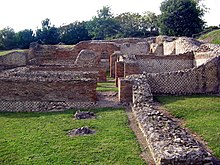
At one point in history, a distinct group of Oscan-speaking tribes fromSamnium(in south-central Italy), theSamnites,moved down into Campania. Since the Samnites were more warlike than the other Oscan populations, they easily took over the cities ofCapuaand Cumae, in an area which was one of the most prosperous and fertile in theItalian Peninsulaat the time.[18]During the 340s BC, the Samnites were engaged in a war with theRoman Republicin a dispute known as theSamnite Wars,with Rome claiming the rich pastures of northern Campania during theFirst Samnite War.[19]The First Samnite War was initiated when the Etruscan-influenced Oscan city of Capua (inEtruscanCapeva) was being attacked by the Samnites, and thus appealed to Rome for defensive help.
As the majority ofSouthern Italywas under Roman control at the time, the sole major remaining independent settlement in the region was theGreekcolony ofNeapolis,and when the city was eventuallycaptured by the Samnites,the Neapolitan Greeks were left with no option but to call on theRomans,with whom they established an alliance, setting off theSecond Samnite War.[18]TheRoman consulQuintus Publilius Filo recaptured Neapolis by 326 BC and allowed it to remain a Greek city with some autonomy as acivitasfoederatawhile strongly aligned with Rome.[20]The Second Samnite War ended with the Romans controlling all of southern Campania and additional regions further to the south, such as parts ofLucania.[19]
Roman period[edit]
Campania was a full-fledged part of theRoman Republicby the end of the 4th century BC, valued for itspasturesand rich countryside. Naples, with itsGreek languageand customs, made it a centre of Hellenistic culture for the Romans, creating the first traces ofGreco-Romanculture.[21]During thePyrrhic Warin 275 BC, theBattle of Beneventumtook place in Campania in the Samnite city of Maleventum, in which the Romans, led by the consulCurius Dentatus,were victorious. They renamed it Beneventum (modern dayBenevento), which grew in stature until it was second only to Capua in southern Italy.[22]During theSecond Punic Warin 216 BC, Capua, in a bid for equality with Rome, allied withCarthage.[23]The rebellious Capuans were isolated from the rest of Campania, which remained allies of Rome.NaplesresistedHannibaldue to the imposing walls.[21]Capua was eventually starved into submission in theRoman retaking of 211 BC,and the Romans were victorious.[23]

With the initial exception of Naples, the region adoptedLatinas official language, in that sense gradually replacing the native Oscan and the Greek and the Etruscan still talked respectively in their colonies of the region,[24][25][26]subsequently becoming fullyRomanised.[27][28]As part of theRoman Empire,Campania, withLatium,formed the most important region of theAugustandivisions ofItalia,theRegio I Latium et Campania;Campania was one of the main areas forgranary.[28]In ancient times Misenum (modern 'Miseno'), at the extreme northern end of the bay of Naples, was the largest base of the Roman navy, since its port (Portus Julius) was the base of the Classis Misenensis, the most important Roman fleet. It was first established as a naval base in 27 BC by Marcus Agrippa, the right-hand man of the emperor Augustus.Roman Emperorschose Campania as a holiday destination, among themClaudiusandTiberius,the latter of whom is infamously linked to the island ofCapri.[21]It was also during this period thatChristianitycame to Campania. Two of theapostles,St. PeterandSt. Paul,are said to have preached in the city of Naples, and there were also severalmartyrsduring this time.[29]The period of relative calm was violently interrupted by the epic eruption ofMount Vesuviusin 79 which buried the cities ofPompeiiandHerculaneum.[30]With theDecline of the Roman Empire,its last emperor,Romulus Augustus,was put in amanor houseprison nearCastel dell'Ovo,Naples, in 476, ushering in the beginning of theMiddle Agesand a period of uncertainty in regard to the future of the area.[21]
Feudalism in the Middle Ages[edit]
The area had manyduchiesandprincipalitiesduring theMiddle Ages,in the hands of theByzantine Empire(also referred to as the Eastern Roman Empire) and theLombards.Under theNormans,the smallerindependent stateswere brought together as part of theKingdom of Sicily,before the mainland broke away to form theKingdom of Naples.It was during this period that elements ofSpanish,FrenchandAragoneseculture were introduced to Campania. Allegiances with the MuslimSaracenswere made in 836, and the Arabs were requested to repel the siege ofLombardtroops coming from the neighbouringDuchy of Benevento.[31][32]
The Kingdom[edit]
Norman to Angevin[edit]
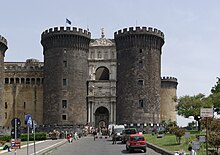
After a period as a Norman kingdom, theKingdom of Sicilypassed to theHohenstaufens,who were a powerful Germanicroyal houseofSwabianorigins.[33]TheUniversity of Naples Federico IIwas founded byFrederick IIin the city, the oldest state university in the world, making Naples the intellectual centre of the kingdom.[34]Conflict between the Hohenstaufen house and thePapacy,led in 1266 toPope Innocent IVcrowningAngevin DynastydukeCharles Ias the king.[35]Charles officially moved the capital fromPalermoto Naples where he resided at theCastel Nuovo.[36]During this period, muchGothic architecturesprang up around Naples, including theNaples Cathedral,the main church of the city.[37]
In 1281, with the advent of theSicilian Vespers,the kingdom split in half. The AngevinKingdom of Naplesincluded the southern part of the Italian peninsula, while the island ofSicilybecame theAragoneseKingdom of Sicily.[35]The wars continued until thepeace of Caltabellottain 1302, which sawFrederick IIIrecognised as king of the Isle of Sicily, whileCharles IIwas recognised as theking of NaplesbyPope Boniface VIII.[35]Despite the split, Naples grew in importance, attractingPisanandGenoesemerchants,[38]Tuscanbankers, and with them some of the most championedRenaissanceartists of the time, such asBoccaccio,PetrarchandGiotto.[39]Alfonso Iconquered Naples after his victory against the lastAngevinking,René,and Naples was unified for a brief period with Sicily again.[40]
Aragonese to Bourbon[edit]

Sicily and Naples were separated in 1458 but remained as dependencies ofAragonunderFerrante.[41]The new dynasty enhanced Naples' commerce by establishing relations with theIberian peninsula.Naples also became a centre of the Renaissance, with artists such asLaurana,da Messina,SannazzaroandPolizianoarriving in the city.[42]During 1501 Naples came under direct rule fromFranceat the time ofLouis XII,as Neapolitan kingFrederickwas taken as a prisoner to France; this lasted four years.[43]Spainwon Naples at theBattle of Gariglianoand, as a result, Naples then became part of theSpanish Empirethroughout the entireHabsburg Spainperiod.[43]The Spanish sentviceroysto Naplesto directly deal with local issues: the most important of which wasPedro Álvarez de Toledo,who was responsible for considerable social, economic and urban progress in the city; he also supported theInquisition.[44]
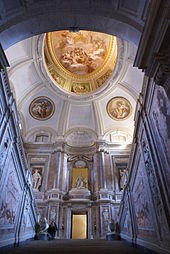
During this period Naples became Europe's second largest city afterParis.[45]During theBaroqueera it was home to artists includingCaravaggio,RosaandBernini;philosophers such asTelesio,Bruno,CampanellaandVico;and writers such asBattista Marino.A revolution led by localfishermanMasaniellosaw the creation of a brief independentNeapolitan Republic,though this lasted only a few months before Spanish rule was regained.[43]Finally, by 1714, the Spanish ceased to rule Naples as a result of theWar of the Spanish Succession;it was theAustrianCharles VIwho ruled fromVienna,similarly, with viceroys.[46]However, the War of the Polish Successionsaw the Spanish regain Sicily and Naples as part of apersonal union,which in theTreaty of Viennawere recognised as independent under acadet branchof the SpanishBourbonsin 1738 underCharles VII.[47]
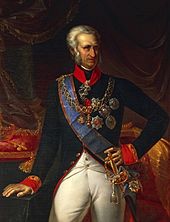
During the time ofFerdinand IV,theFrench Revolutionmade its way to Naples:Horatio Nelson,an ally of the Bourbons, even arrived in the city in 1798 to warn against it. However, Ferdinand was forced to retreat and fled toPalermo,where he was protected by aBritish fleet.[48]Naples'lower classes(thelazzaroni) were pious andRoyalist,favouring the Bourbons; in the mêlée that followed, they fought the Neapolitan pro-Republicanaristocracy, causing acivil war.[48]The Republicans conqueredCastel Sant'Elmoand proclaimed aParthenopaean Republic,secured by theFrench Army.[48]Acounter-revolutionaryreligious army oflazzaroniunderFabrizio Ruffowas raised; they had great success and the French surrendered the Neapolitan castles and were allowed to sail back toToulon.[48]
Ferdinand IV was restored as king; however, after only seven yearsNapoleonconquered the kingdom and instatedBonapartistkings including his brotherJoseph Bonaparte.[49]With the help of theAustrian Empireand allies, the Bonapartists were defeated in theNeapolitan Warand Bourbon Ferdinand IV once again regained the throne and the kingdom.[49]TheCongress of Viennain 1815 saw the kingdoms of Naples and Sicily combined to form theTwo Sicilies,[49]with Naples as the capital city. Naples became the first city on the Italian peninsula to have arailwayin 1839,[50]there were many factories throughout the kingdom making it a highly important trade centre.[51]
World War II[edit]
In September 1943, Salerno was the scene ofOperation Avalancheand suffered a great deal of damage. From 12 February to 17 July 1944, it hosted the Government of MarshalPietro Badoglio.In those months Salerno was the temporary "Capital of theKingdom of Italy",and the KingVictor Emmanuel IIIlived in a mansion in its outskirts. Salerno received the first "Tricolore" in an official ceremony on 7 January 2012 from the premierMario Monti,to celebrate the glorious story of Italy and its old capitals.
Geography[edit]
Campania has an area of 13,590 km2(5,247 sq mi) and a coastline of 500 km (311 mi) on theTyrrhenian Sea.[52]Campania is famous for its gulfs (Naples, Salerno and Policastro) as well as for three islands (Capri,IschiaandProcida).
Four other regions border Campania;Lazioto the northwest,Moliseto the north,Apulia(Puglia) to the northeast andBasilicatato the east.
The mountainous interior is fragmented into severalmassifs,rarely reaching 2,000 m (6,562 ft) (Miletto of 2,050 m (6,726 ft)),[53]whereas close to the coast there are volcanic massifs:Vesuvio(1,281 m (4,203 ft))[54]andCampi Flegrei.
The climate is typicallyMediterraneanalong the coast with warm, sunny and sultry summers and mild, rainy winters, whereas in the inner zones it is more continental, with lower temperatures in winter and warm summers. Snow is possible at higher elevations but rare at sea level. 51% of the total area is hilly, 34% mountainous and the remaining 15% is made up of plains.[55]There is a highseismic riskacross the region.
-
Naples (Nunziatella Military School)
-
IslandCapri
-
IslandIschia
-
Typical landscape inProvince of Avellino,also known asIrpinia
-
Canyons of Forre del Titerno,Province of Benevento
Economy[edit]
The GDP per capita in Campania is rank 18 from 20 Italian regions, surpassing onlySicilyandCalabria.[56]It is only 66.7% of the Italian average. It has been speculated that a factor could be the failure to connect the region's economy with the rest of Italy, while another factor could be its peripheral position with respect to the developed central areas of Europe.[57]
Overall, Campania appears to be a region with great economic potential, which is partly held back byorganized crime(Camorra) and the resulting corruption.[58]The economy of Campania is one of the most affected nationwide by the economic and financial crisis that began in 2008,[59]but between 2015 and 2016 it came out of the recession and began to recover due to, above all, industry, but also tourism and tertiary.[60]
Tourism[edit]

Tourism is supported by the abundant presence of artistic and naturalistic beauty which attract millions of people from all over the world every year. Precisely in this sector the region finds its strong point (through which it was able to react to the recession in 2015), in fact, according to 2018 studies done byEurostat,Campania is in the top 20 of the most visited regions in Europe and fifth in Italy afterLombardy,Lazio,VenetoandTuscany(in order), as well as first among the southern regions.[61]
The tourist flow sees more than half of the Italian and foreign tourists of the entire region gather in theMetropolitan City of Naples.[62]Of all the locations,PompeiiandHerculaneumstand out, two of the most visited archaeological sites in Italy and among the most visited in the world where there is an average of four million tourists a year.[63]Then there are theCampanian Archipelago(Capri,IschiaandProcida,the latter named Italian capital of culture in 2022),Vesuviusand theSorrentocoast; a notable growth in the cruise sector was observed in thePort of Naples.[64]
Tourist data on other sites in Campania show important records that the region holds nationally and worldwide. Among these above all the data relating to Capri (which is the most visited minor island in Italy and among the most sought-after in the world),[65]theAmalfi Coast(which is among the most visited sites in Italy)[66]and finally Vesuvius (the most visited and well-known volcano in the world).[67][68]There is also a growing influx of tourists toCilento(PaestumandCertosa di Padula.[69]
Campania has many small and picturesque villages, 11 of them have been selected byI Borghi più belli d'Italia(English:The most beautiful Villages of Italy),[70]a non-profit private association of small Italian towns of strong historical and artistic interest,[71]that was founded on the initiative of the Tourism Council of the National Association of Italian Municipalities.[72]
Decline of heavy industry[edit]

Campania is traditionally the most industrialized region of southern Italy, particularly the Neapolitan territory was one of the most industrialized areas of Italy until the beginning of the 20th century, preceded only by the provinces of the so-called "industrial triangle" (Milan,TurinandGenoa).[73]
In recent decades, the gap with respect to other regions is no longer as significant as it used to be, given that southern regions such asApuliaandAbruzzohave grown considerably economically, while Campania has paradoxically undergone a constant process of de-industrialisation. The symbol of this phenomenon is the reclamation process of the area inBagnoliwhere the formerItalsiderandEternitoperated promoted by the region.[74]
Food and agriculture[edit]
Campania mainly produces fruit and vegetables, but has also expanded its production of flowers grown in greenhouses, becoming one of the leading regions of the sector in Italy.[75]In 2021 thevalue addedof this sector represents around 2.34% of the total value added of the region, equalling €2.2 billion.[76]Campania produces over 50% of Italy's nuts and is also the leader in the production of tomatoes.[77]
Typical products are:
-
Apple "Annurca"with distinctive ripening process
-
Vesuvianapricot
-
Neapolitanpeach
-
Huge lemon ofSorrentoandAmalfi Coast
-
Sorrentoorange
-
White fig ofCilento
-
San Marzanotomato
-
Pasta ofGragnano
-
Liqueur "Limoncello"
A distinctive point of regional agriculture in the breeding ofbuffalos.The milk is used to producemozzarella di bufala.
Olive trees,mainly of the varieties Carpellese(PDO designated),[78]Cornia (Val di Cornia DOC),Frantoio,Leccino,Ogliarola Barese, Olivella, Ortice, Pisciottana (Also Ogliastrina or Olivo dell'Ascea),[79]Ravece (also known as Rotondello),[80]and Salella,[81]covers over 74,604 hectares (184,350 acres).
Vineyards cover 41,129 ha, but only ca. 5,100 ha using to produce quality wine ofDOCandDOCGtypes. There are 4 DOCG wines: Aglianico del Taburno (red and rose), Fiano di Avellino (white), Greco di Tufo (white and sparkling) and Taurasi (red). Wine production has increased as well as the quality of the wine.[82]
There is a problem withillegal toxic waste dumpin theTriangle of deathnorth ofNaplesbetweenAcerra,NolaandMarigliano.[83][84]In the region, over 12,000 cattle, river buffaloes and sheep had beenculledbefore 2006.[85]High levels of mortality and abnormal foetuses were also recorded in farms in Acerra linked to elevated levels of dioxin.[85]Local studies have shown higher than permissible levels ofleadin vegetables grown in the area.[86]The government blames the Mafia's illegal garbage disposal racket.[86]In samples of milk, which is using to producemozzarella di bufala,found cancerogenicdioxine.[87]InNaples-Bagnoliis anasbestoscontamination from formerEternitcement plant.[88]Millions of tons of toxic industrial waste has been dumped in Campania, not only in the Triangle of death, a region once celebrated for the fertility of its soil, but now the local population have been exposed to land contaminated with waste. This includes highly dangerous materials such asasbestos,zinc,lead,germanium,arsenic,mercury,cadmium,chromium,dioxinanduranium.Blood tests of people living in Campania show alarming levels of dioxins.[89]
Automotive[edit]
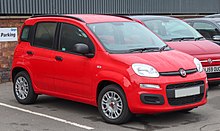
Campania had a massiveautomotiveindustrial production till 2011, focused onAlfa Romeo.[90]Production ofAlfa Romeowas reduced and relocated to plant inCassinonearRome.Currently only one low-levelFiat Pandamodel is produced in facilities located inPomigliano d'Arcoin the Naples metropolitan area (140,478 units in 2020).[91]A FIAT plant manufacturing engines is inPratola Serra,Avellino.There are also plants for automotive parts suppliers likeMagneti Marelli(exhaust systems) andDenso(engine cooling and air-conditioners). Buses are produced by Industria Italiana Autobus inFlumeri(ex-Irisbus).
Aerospace and rail[edit]
There is also a significantaerospace industry:
- A failedMarsmission namedExoMarsin 2016 had a major part of its technology designed in Naples[92]No signal indicating a successful landing was received.[93]
- Also inPomigliano d'Arcothere are aLeonardoplant, which produces the fuselage and tail ofATRplanes[94]and anAvio Aeroplant, which manufactures parts of gas turbines.Beneventohas aLeonardo Helicoptersplant (aluminum and magnesium castings)[94]
- Radars for military and air traffic control applications and components are produced by two other Leonardo establishments inGiugliano in CampaniaandBacoli[94]
- VulcanairinCasoriamanufactures light aircraft
- Seekersfor missiles are made inBacoli-FusarobyMBDA
Hitachi Rail Italyhas headquarters, manufacturing plant and service facilities inNaples.Here it produces the metro trainsMeneghinoandDriverless Metro.[95]
Fashion[edit]
Luxury brands likeKiton,Cesare Attolini,Isaia,Rubinacci,Harmont & Blaine,E. Marinellaare also located in Campania. All of them are relative small-sized with annual sales of less than 100 million euros each.
Other industrial districts[edit]
There are other industrial districts in Campania:

- JewelryinMarcianise,one of the four located in Italy. It has 350 companies with ca. 2500 employees, and the annual turnover is 750 million euros. Every two years there is a special fair.
- Coralproducts,cameosandnacreinTorre del Greco.Since 1989 in Torre del Greco coral fishing is not practised, but the town still remains the most important centre in the world for coral processing, with over 2,000 employees in the sector.
- Leather tanninginSolofraextends over an area of about 60 km2in the south-western area of the province of Avellino, including alsoMontoroandSerino.This area is specialized in the tanning of sheep and goatskins, for a total of about 400 companies operating in the sector including tanneries, subcontractors and garment manufacturers, 4,000–4,500 employees and an average annual turnover of 1,500 million euros. It specializes in the processing of leathers for clothing, shoes and leather goods.
- Shoe making inGrumo Nevano,Aversa,Trentola Ducenta
Transport[edit]
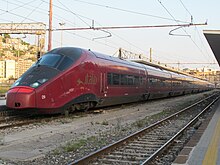
The region has a dense network of roads and motorways, a system of maritime connections and an international airport (Naples Airport). The port of Naples connects the region with theMediterranean basin,and brings tourists to thearchaeological sites,the cities of art (Naples and Caserta), to the coastal areas and to the islands.
Rail[edit]
There are high-speed rail lines:
There is a maintenance and service centre for high-speed trainsAlstom AGVinNola.
Maritime[edit]
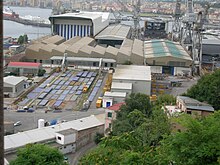
Sea-based activity accounts for about 3.9% of the economy, which includes port movements of goods and passengers and sea transportation, as well as a sizable seaside tourism economy. InCastellammare di Stabiathere is a bigFincantierishipyard. Shipping companiesGrimaldiandTirreniaboth headquarter inNaples.
Service[edit]
The services sector makes up for 78% of the region's gross domestic product.[82]
Unemployment[edit]
The unemployment rate stood at17.4%in 2022 and was one of the highest in Italy.[96]
| Year | 2006 | 2007 | 2008 | 2009 | 2010 | 2011 | 2012 | 2013 | 2014 | 2015 | 2016 | 2017 | 2018 | 2019 | 2020 | 2021 | 2022 |
|---|---|---|---|---|---|---|---|---|---|---|---|---|---|---|---|---|---|
| unemployment rate (in %) |
12.8% | 11.2% | 12.5% | 12.9% | 13.9% | 15.4% | 19.2% | 21.5% | 21.7% | 19.8% | 20.4% | 20.9% | 20.4% | 20.0% | 17.9% | 19.3% | 17.4% |
Demographics[edit]
| Year | Pop. | ±% |
|---|---|---|
| 1861 | 2,402,355 | — |
| 1871 | 2,520,095 | +4.9% |
| 1881 | 2,659,688 | +5.5% |
| 1901 | 2,914,073 | +9.6% |
| 1911 | 3,101,593 | +6.4% |
| 1921 | 3,343,293 | +7.8% |
| 1931 | 3,508,774 | +4.9% |
| 1936 | 3,696,632 | +5.4% |
| 1951 | 4,346,264 | +17.6% |
| 1961 | 4,760,759 | +9.5% |
| 1971 | 5,059,348 | +6.3% |
| 1981 | 5,463,134 | +8.0% |
| 1991 | 5,630,280 | +3.1% |
| 2001 | 5,701,931 | +1.3% |
| 2011 | 5,766,810 | +1.1% |
| 2021 | 5,624,420 | −2.5% |
| Source:ISTAT | ||
The region, with a population of over 5.8 million inhabitants, is divided into five provinces: Naples, Benevento, Avellino, Caserta and Salerno. Over half of the population is resident in the province of Naples, where there is a population density of 2,626 inhabitants per km2. Within the province, the highest density can be found along the coast, where it reaches 13,000 inhabitants per km2 in the city of Portici. The region, which was characterised until recently by an acute economic contrast between internal and coastal areas, has shown an improvement in the last decade thanks to the development of the provinces of Benevento and Avellino. At the same time, the provinces of Naples, Caserta and in part Salerno, have developed a variety of activities connected to advanced types of services.[97]
Immigration and ethnicity[edit]
| Nationality | Population |
|---|---|
| 37,834 | |
| 33,334 | |
| 23,252 | |
| 16,506 | |
| 11,896 | |
| 8,648 | |
| 8,147 | |
| 7,966 | |
| 7,689 | |
| 6,855 |
Unlike central andnorthern Italy,in the first decade of the 2000s the region of Campania has not attracted large numbers of immigrants, despite having increased from approximately 100,000 in 2007 to 240,000 in 2021. The Italian national institute of statisticsISTATestimated in December 2022 that 241,008 foreign-born immigrants live in Campania, equal to 4.32% of the total regional population.[99]Part of the reason for this is in recent times, there have been more employment opportunities in northern regions than in theSouthern Italianregions.
Government and politics[edit]
ThePolitics of Campania,takes place in a framework of apresidentialrepresentative democracy,whereby the President of Regional Government is thehead of government,and of a pluriformmulti-party system.Executive poweris exercised by the Regional Government.Legislative poweris vested in both the government and the Regional Council.
The Regional Council of Campania (Consiglio Regionale della Campania) is composed of 60 members, of which 47 are elected in provincial constituencies withproportional representation,12 from the so-called "regional list" of the elected president and the last one is for the candidate for president who comes second, who usually becomes the leader of the opposition in the council. If a coalition wins more than 55% of the vote, only 6 candidates from the "regional list" will be elected and the number of those elected in provincial constituencies will be 53.[100]

Administrative divisions[edit]
Campania is divided into four provinces and one metropolitan city:
| Province | Area (km2) | Population | Density (inhabitants/km2) |
|---|---|---|---|
| Province of Avellino | 2,792 | 427,310 | 153 |
| Province of Benevento | 2,071 | 283,393 | 136.83 |
| Province of Caserta | 2,639 | 906,596 | 343.54 |
| Province of Salerno | 4,923 | 1,092,349 | 222.11 |
| Metropolitan City of Naples | 1,171 | 3,052,763 | 2,606.97 |
Culture[edit]
Cuisine[edit]
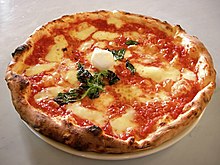
Campanian cuisine varies within the region. While Neapolitan dishes centre on seafood, Casertan and Aversan ones rely more on fresh vegetables and cheeses. The cuisine from Sorrento combines the culinary traditions from both Naples and Salerno.Pizzawas conceived in Naples.[101]Spaghettiis also a well-known dish from southern Italy and Campania.

Campania produces wines includingLacryma Christi,Fiano,Aglianico,Greco di Tufo,Falerno del Massico,Taburno,Solopaca,andTaurasi.The cheeses of Campania consist ofMozzarella di Bufala (buffalo mozzarella)(mozzarella made from buffalo milk), fiordilatte ( "flower of milk" ) a mozzarella made from cow'smilk,ricottafromsheeporbuffalomilk,provolonefrom cow milk, andcaciottamade from goat milk.Buffaloare bred in the provinces ofSalernoandCaserta.
Several different cakes and pies are made in Campania.Pastierapie is made duringEaster.CasatielloandtortanoareEaster breadsmade by adding lard or oil and various types of cheese to bread dough and garnishing it with slices ofsalami.Babàcake is a well known Neapolitan delicacy, best served withrumorlimoncello(a liqueur invented in theSorrento peninsula). It is an oldAustriancake, which arrived in Campania during the Austrian domination of theKingdom of Two Siciliesand was modified there to become a "walking cake" for citizens always in a hurry for work and other pursuits.Sfogliatellais another pastry from theAmalfi Coast,as isZeppole,traditionally eaten onSaint Joseph's day.Struffoli,little ballsfried doughdipped inhoney,are enjoyed during the Christmas holidays.

Another Campanian dish is the so-calledRussian salad,also known as Olivier salad, which is based on similar dishes fromFrance.It is made of potatoes inmayonnaisegarnished withshrimpand vegetables in vinegar. Another French-derived dish is "gattò" or "gâteau di patate" (an oven-baked pie made of boiled potatoes). As with the Russian salad, Campania is home to popular seafood-based dishes, such as "insalata di mare" (seafood salad), "zuppa di polpo" (octopus soup), and "zuppa di cozze" (mussel soup). Other regional seafood dishes include "frittelle di mare" (fritters with seaweed), made with edibleposeidoniaalgae, "triglie al cartoccio" (red mullet in the bag), and "alici marinate" (fresh anchovies in olive oil). The island of Ischia is known for its fish dishes, as well as for cooked rabbit. Campania is also home to the lemons ofSorrento.Rapini(or Broccoli rabe), known locally asfriarielli,are often used in regional cooking. Campania also produces many nuts, especially in the area of Avellino, Salerno and Benevento.Hazelnutproduction is especially relevant in the province of Avellino – inSpanish,inPortugueseand inOccitanthe hazelnut is respectively calledavellana,avelãandavelano,[102]after the city ofAvella.That is also the case of ancient Italianavellana,which is however not in use anymore.
Ancient, medieval, and early arts[edit]

The region of Campania is rich with a vast array of culture and history. Since theGreek colonyofElea,nowVelia,Campania was home to philosophers of thePre-Socratic philosophyschool, such asParmenidesandZeno of Elea,who came to prominence around 490–480 BC. TheLatinpoetVergil(70 BC–19 BC) settled in Naples in his late-life: parts of hisepic poemAeneidare located in Campania. The ancient scientistPliny the Elderstudied Mount Vesuvius and died after being poisoned and killed by gas emitted from the volcano during the 79 AD eruption.
Romulus Augustus,the last emperor of theWestern Roman Empire,died as a prisoner of the German generalOdoacerat Naples around 500. In theMiddle Ages,the artistGiottomade some frescoes inCastel Nuovo.These works of art were subsequently destroyed by an earthquake.
By the end of the Middle Ages, themedical schoolofSalerno,which combined ancient Roman andGreek medicinewith Arab medicine, was known throughout Europe and its methods were adopted across the continent. Some have suggested that this may have been one of the first universities in Europe.Boccaccio,the Tuscan poet, visited Naples on various occasions, and in theDecamerondescribed it as a dissolute city. He also wrote a love story involving a noblewoman close to the King of Naples.
In 1570, the Spanish writerMiguel de Cervantes,who wrote theromancenovelDon Quixote,served as a Spanish soldier for a period in Naples. PoetTorquato Tassowas born in Sorrento in 1575. Years earlier in 1558, the first modern description and studies of the "camera obscura" ( "dark chamber"), were established in Italy byGiovanni Battista della Portain hisMagiae Naturalis.
PhilosopherGiordano Brunowas born inNola.He was the first to theorize infinite suns and infinite worlds in the universe. He was burnt inRomeby theSpanish Inquisitionin 1600. Later, inc. 1606,the Baroque painterCaravaggioestablished his studio in Naples. Italian Baroque architectCosimo FanzagofromBergamoalso decided to move to Naples.
In the 18th century, Naples was the last city to be visited by philosophers who created the "Grand Tour" which was the big touring voyage to visit all the important cultural sites of the European continent. Italian architectLuigi Vanvitellison ofDutcharchitectCaspar van Wittelbuilt theRoyal PalaceinCasertainc. 1750.He contributed to the construction of manyneoclassic-stylepalaces in which the nobles of Naples spent their holidays. These palaces are now known worldwide as "Ville Vesuviane".[103]
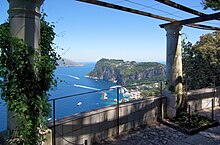
Raimondo di Sangro,prince of Sansevero, was a scientist and one of the last alchemists. Around this time, in 1786, German writerGoethevisited Campania and Naples. German archaeologistJohann Joachim Winckelmannalso visited Naples, Paestum, Herculaneum and Pompeii in 1748 and later, studying how archaeological surveys were conducted in the kingdom of Naples. He was one of the first to study drawings, statues, stones, and ancient burned scrolls made of papyrus found in the excavations of the city of Herculaneum. Archaeological excavations in Pompeii were initiated by King Charles III of Naples in 1748. He issued the first modern laws in Europe to protect, defend and preserve archaeological sites. Neapolitan musicians of that period includeNiccolò Antonio ZingarelliandGiovanni Paisiello.
MusicianGioachino Rossinilived for several years in Naples, where he wrote numerous compositions.Italian poetand writerGiacomo Leopardiestablished his home in Naples andTorre del Greco,remaining there at the end of his brief young life. He died at Naples in 1837. The firstvolcano observatory,theVesuvius Observatory,was founded in Naples in 1841. GeologistGiuseppe Mercalli,born inMilanin 1850, was a director of the Vesuvius Observatory.
In February 1851, British statesmanWilliam Ewart Gladstonewas allowed to visit the prison where Giacomo Lacaita, legal adviser to the British embassy, was imprisoned by the Neapolitan government, along with other political dissidents.[104]He deplored their condition, and in April and July, he published twoLetters to the Earl of Aberdeenagainst the Neapolitan government, followed byAn Examination of the Official Reply of the Neapolitan Governmentin 1852.[105]His pamphlets may have contributed to the cause of theunification of Italyin 1861.
French writerAlexandre Dumas, pèrewas directly involved in the process of the Unification of Italy and sojourned two or three years in Naples, where he wrote severalhistorical novelsregarding that city. He was also a known newspaper correspondent.Francesco de Sanctis,writer, politician and twice Minister of Instruction after the reunification of Italy in 1861, was born inMorra De Sanctisnear Avellino.
German scientistAnton Dohrnfounded in Naples the first public aquarium in the world and laboratory for the study of the sea, known as Maritime Zoological Station. The Astronomic Observatory of Capodimonte was founded by KingJoachim Murat,in 1816. The observatory now hosts the Italian Laboratory of Astrophysics. Doctors and surgeonsAntonio CardarelliandGiuseppe Moscatiwere representatives of medical studies in Naples.
Contemporary and modern arts[edit]
The so-called "School of Posillipo"and"School of Resina",dating from the late 19th to early 20th centuries, included painters, such asGiacinto Gigante,Federico Cortese,Domenico Morelli,Saverio Altamura,Giuseppe De Nittis,Vincenzo Gemito,Antonio Mancini,andRaffaello Pagliaccetti.
Amongst the painters who inspired directly these schools, areSalvator Rosa,Pierre-Jacques Volaire,andAnton Sminck van Pitloo,who spent his last years in Naples. Opera singerEnrico Carusowas also a native of Naples. Russian revolutionary leaderVladimir Leninlived for a period inCapri.In the 20th century, the music genre calledNeapolitan songbecame popular worldwide, with songs such as "'O sole mio","Funiculì, Funiculà","'O surdato 'nnammurato","Torna a Surriento","Santa Lucia","Malafemmena","'A vucchella",and"Passione".
MathematicianRenato Caccioppoli,nephew of the Russian anarchic revolutionaryMikhail Bakunin,was born inNaples.The firstPresident of the Italian Republicin 1946 (with a pro-tempore mandate of six months) wasEnrico De Nicolafrom Torre del Greco. Campania is also home to the formerPrime Ministerand 6th President of the RepublicGiovanni Leone,as well as the 11th President,Giorgio Napolitano.

The 20th century's best known philosopher and literate in Naples wasBenedetto Croce,known for his studies inaesthetics,ethics,logic,economy,history,politics.
Neapolitan artists, actors, playwrights, and showmen includedEduardo De FilippoandPeppino De Filippo,and their sisterTitina De Filippo.Totò(byname of Antonio de Curtis) was one of the most important comedians in Naples in the 20th century. He is also known for the song "Malafemmena".
Pop artistAndy Warholcreated two famous paintings of the1980 Irpinia earthquake:Fate prestoandVesuvius 365.Both originals are hosted in the exhibitTerrae Motusin the Palace of Caserta.
Oscar–winning actressSophia Lorengrew up inPozzuoli.
Oscar andDavid-winning[106]film producerDino De Laurentiiswas born inTorre Annunziata.One of his grandchildren isFood NetworkpersonalityGiada De Laurentiis.
Contemporary Campanian writers includeCurzio MalaparteandRoberto Saviano.
20th- and 21st-century Campanian actors and directors includeFrancesco Rosi,Iaia Forte,Pappi Corsicato,Teresa De Sio,Lello Arena,Massimo Troisiand directorGabriele Salvatores.
Modern Italian singers and musicians from Campania includePeppino di Capri,Renato Carosone,Edoardo Bennato,Eugenio Bennato,Mario Merola,Sergio Bruni,Aurelio Fierro,Roberto Murolo,Tony Tammaro,Teresa De Sio,Eduardo De Crescenzo,Alan Sorrenti,Tullio De Piscopo,Massimo Ranieri,Pino Daniele,James Seneseand his groupNapoli Centrale,Enzo Avitabile,Enzo Gragnaniello,Nino D'Angelo,Gigi D'Alessio,99 Posse,andAlmamegretta.
Artists who directed movies about Naples or actors who played in movies in Campania, or interpreted Neapolitans on-screen, includeVittorio De Sica,Domenico Modugno,Renzo Arbore,Lina Wertmüller,Mario LanzaasCaruso,Clark Gablein "It Started in Naples",andJack Lemmonin the movies "Maccheroni"(which co-starredMarcello Mastroianni) and "Avanti!".
The internationalGiffoni Film Festival,established in 1971, is the first and most important festival for a young public.
Sports[edit]
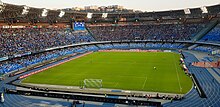
Campania is home to several national football,futsal,water polo,volleyball, basketball and tennis clubs.
The fencing school in Naples is the oldest in the country and the only school in Italy in which a swordsman can acquire the title "master of swords", which allows him or her to teach the art offencing.
The "Circolo Savoia" and "Circolo Canottieri Napoli"sailing clubs are among the oldest in Italy and are known for their regattas. These are also home of the main water polo teams in the city. Many sailors from Naples and Campania participate as crew in theAmerica's Cupsailing competition.
RowersGiuseppe AbbagnaleandCarmine Abbagnalewere born inCastellammare di Stabia:they were four timesrowingworld champions andOlympicgold medalists.
Across the top 3 levels ofItalian football,the clubs in Campania include:
- S.S.C. Napoliplaying inSerie A,and the only team in the south of Italy to have won the Serie A title
- U.S. Salernitana 1919playing inSerie A
- Benevento Calcioplaying inSerie C
- U.S. Avellino 1912playing inSerie C
- S.S. Juve Stabiaplaying inSerie C
- S.S. Turris Calcioplaying inSerie C
Notes[edit]
- ^/kæmˈpeɪniə/kam-PAY-nee-ə,UKalso/kæmˈpæniə/kam-PAN-ee-ə,USalso/kɑːmˈpɑːniə/kahm-PAH-nee-ə,[4][5]Italian:[kamˈpaːnja],Neapolitan:[kamˈbɑːnjə].
References[edit]
- ^CampaniainGeonames.org (cc-by)
- ^"Population on 1 January by age, sex and NUTS 2 region",ec.europa.eu,archivedfrom the original on 25 December 2023,retrieved29 December2023
- ^"Sub-national HDI - Area Database - Global Data Lab".hdi.globaldatalab.org.Archivedfrom the original on 23 September 2018.Retrieved5 March2023.
- ^"Campania".Collins English Dictionary.HarperCollins.Archivedfrom the original on 6 May 2019.Retrieved6 May2019.
- ^Upton, Clive;Kretzschmar, William A. Jr. (2017).The Routledge Dictionary of Pronunciation for Current English(2nd ed.). Routledge. p. 183.ISBN978-1-138-12566-7.
- ^"Campania, Italy".Archivedfrom the original on 24 September 2021.Retrieved24 September2021.
- ^demo.istat.it (ed.)."Bilancio demografico Anno 2018 (dati provvisori)".Archived fromthe originalon 14 January 2018.Retrieved30 April2015.
- ^"Statistics on European cities - Statistics Explained".ec.europa.eu.Archivedfrom the original on 12 June 2020.Retrieved20 April2020.
- ^"UNESCO - MAB Biosphere Reserves Directory".unesco.org.Archivedfrom the original on 5 January 2020.Retrieved20 April2020.
- ^Gradogna, Sergio (10 February 2010)."Non solo greci e romani, la Campania degli altri popoli".Charme(in Italian).Archivedfrom the original on 19 February 2022.Retrieved19 February2022.
- ^"Campania: Gateway to Southern Italy".LifeInItaly. 7 October 2007.Archivedfrom the original on 15 August 2009.Retrieved22 July2009.
- ^(Giacomo Devoto, Gli antichi italici, Firenze, Vallecchi, 1931, p.118).
- ^"Italia Antiqua – XV, Campania".InStoria.it. 7 October 2007.Archivedfrom the original on 27 December 2008.Retrieved22 July2009.
- ^"Etruria campana".Archivedfrom the original on 14 December 2021.Retrieved2 September2019.
- ^Strabo,Geographica,V (Italia), 4.3.
- ^Francesco Belsito (2013).Storia di Nocera. Monumenti, personaggi, leggende.Angri, Gaia.
- ^"Campania: History".Interteam.it. 7 October 2007. Archived fromthe originalon 5 May 2005.
- ^ab"The Samnite Wars".UNRV. 7 October 2007.Archivedfrom the original on 28 June 2009.Retrieved22 July2009.
- ^ab"Ancient Times – 1st millennium B.C."Michael Vigorita. 7 October 2007.Archivedfrom the original on 7 October 2008.Retrieved22 July2009.
- ^"Roman Naples".Faculty.ed.umuc.du. 7 October 2007. Archived fromthe originalon 29 June 2009.Retrieved22 July2009.
- ^abcd"Antic Naples".Naples.Rome-in-Italy. 8 January 2008. Archived fromthe originalon 25 December 2008.Retrieved22 July2009.
- ^Oakley, Stephen P (1971).A Commentary on Livy, Books VI-X.Oxford University Press. p. 43.ISBN0-19-927143-7.
- ^ab"Second Punic War: Second Period, From The Revolt Of Capua To The Battle Of The Metaurus – b.C. 215-207".Roman-Empire.info. 8 January 2008. Archived fromthe originalon 12 October 2009.Retrieved22 July2009.
- ^Freeman, Philip (1999).The Survival of EtruscanArchived8 August 2022 at theWayback Machine.Page 82: "Oscan graffiti on the walls of Pompeii show that non-Latin languages could thrive in urban locations in Italy well into the 1st century A.D."
- ^McDonald, K. L. (2017)."Fragmentary ancient languages as" bad data ": towards a methodology for investigating multilingualism in epigraphic sources."Archived20 August 2022 at theWayback MachinePages 4-6
- ^Schrijver, Peter.Oscan love of Rome.Page 2.
- ^Lomas, Kathryn, "The Hellenization of Italy", in Powell, Anton.The Greek WorldArchived18 September 2023 at theWayback Machine.Page 354.
- ^ab"Campania: A Little History".Emmeti.it. 8 January 2008.Archivedfrom the original on 29 June 2009.Retrieved22 July2009.
- ^Herbermann, Charles, ed. (1913)..Catholic Encyclopedia.New York: Robert Appleton Company.
- ^"Secrets of the Dead: Pompeii and Herculaneum".Channel4. 8 January 2008.Archivedfrom the original on 29 May 2009.Retrieved22 July2009.
- ^Magnusson & Goring 1990
- ^Hilmar C. Krueger. "The Italian Cities and the Arabs before 1095" inA History of the Crusades: The First Hundred Years,Vol.I. Kenneth Meyer Setton, Marshall W. Baldwin (eds., 1955). University of Pennsylvania Press. p.48.
- ^"Swabian Naples".Faculty.ed.umuc.edu. 7 October 2007. Archived fromthe originalon 1 May 2009.Retrieved22 July2009.
- ^"Italy: PhD Scholarships in Various Fields at University of Naples-Federico II".ScholarshipNet.info. 7 October 2007. Archived fromthe originalon 30 January 2009.Retrieved22 July2009.
- ^abc"Sicilian History".Dieli.net. 7 October 2007.Archivedfrom the original on 4 May 2009.Retrieved22 July2009.
- ^"Naples – Castel Nuovo".PlanetWare. 7 October 2007.Archivedfrom the original on 18 May 2008.Retrieved22 July2009.
- ^Bruzelius, Caroline(1991). ""ad modum franciae": Charles of Anjou and Gothic Architecture in the Kingdom of Sicily ".The Journal of the Society of Architectural Historians.50(4): 402–420.doi:10.2307/990664.JSTOR990664.
- ^Constable, Olivia Remie (2002).Housing the Stranger in the Mediterranean World: Lodging, Trade, and Travel.Humana Press.ISBN1-58829-171-5.
- ^"Angioino Castle, Naples".Naples-City.info. 7 October 2007. Archived fromthe originalon 29 September 2008.Retrieved22 July2009.
- ^"Aragonese Overseas Expansion, 1282–1479".Zum.de. 7 October 2007.Archivedfrom the original on 29 December 2008.Retrieved22 July2009.
- ^"Ferrante of Naples: the statecraft of a Renaissance prince".7 October 2007. Archived fromthe originalon 23 December 2008.
- ^"Naples Middle-Ages".Naples.Rome-in-Italy. 7 October 2007. Archived fromthe originalon 10 April 2008.Retrieved22 July2009.
- ^abc"Spanish acquisition of Naples".Britannica.7 October 2007.Archivedfrom the original on 18 February 2008.Retrieved2 June2022.
- ^"Don Pedro de Toledo".Faculty.ed.umuc.edu. 7 October 2007. Archived fromthe originalon 9 May 2008.Retrieved22 July2009.
- ^"Naples Through the Ages".Fodors. 7 October 2007. Archived fromthe originalon 20 December 2016.Retrieved22 July2009.
- ^"Charles VI, Holy Roman emperor".Bartleby. 7 October 2007. Archived fromthe originalon 18 December 2007.
- ^"Charles of Bourbon – the restorer of the Kingdom of Naples".RealCasaDiBorbone.it. 7 October 2007. Archived fromthe originalon 26 September 2009.Retrieved22 July2009.
- ^abcd"The Parthenopean Republic".Faculty.ed.umuc.edu. 7 October 2007. Archived fromthe originalon 6 March 2001.Retrieved22 July2009.
- ^abc"Austria Naples – Neapolitan War 1815".Onwar. 7 October 2007. Archived fromthe originalon 31 July 2001.Retrieved22 July2009.
- ^"La dolce vita? Italy by rail, 1839–1914".7 October 2007. Archived fromthe originalon 24 June 2011.
- ^"Why Neo-Bourbons".NeoBorbonici.it. 7 October 2007.Archivedfrom the original on 22 April 2021.Retrieved22 July2009.
- ^"Km di costa in Italia"(in Italian).Archivedfrom the original on 23 March 2023.Retrieved16 March2023.
- ^"Da Campitello Matese a Monte Miletto"(in Italian). 20 June 2020.Archivedfrom the original on 18 September 2023.Retrieved16 March2023.
- ^"Vesuvio"(in Italian).Archivedfrom the original on 29 January 2023.Retrieved16 March2023.
- ^"Campania"(in Italian).Archivedfrom the original on 7 February 2023.Retrieved16 March2023.
- ^"Regional GDP per capita ranged from 30% to 263% of the EU average in 2018"(Press release). ec.europa.eu.Archivedfrom the original on 9 October 2022.Retrieved1 September2020.
- ^"Campania", Microsoft Encarta 2008."Econimia della Campania".voyagesphotosmanu.Financial Times. Archived fromthe originalon 9 June 2017.Retrieved30 May2017.
{{cite web}}:CS1 maint: numeric names: authors list (link) - ^Senza la mafia il Sud raggiunge il Nord, CENSISArchived2014-07-09 at theWayback Machine
- ^"Campania, imprese vitali nonostante la crisi".3 June 2013.Archivedfrom the original on 18 January 2018.Retrieved17 January2018.
- ^"Rapporto Svimez, segnali di ripresa per l'economia campana".Archivedfrom the original on 18 January 2018.Retrieved17 January2018.
- ^Dario Raffaele."Turismo: Sicilia fuori dalla top 20 europea".Archived fromthe originalon 31 March 2016.Retrieved10 April2021.
- ^"Turismo, a Napoli e in provincia +8,5% visitatori nel 2011".Archived fromthe originalon 8 April 2014.Retrieved15 February2013.
- ^"Pompei, niente bagni in fuga dagli scavi".Archived fromthe originalon 6 February 2013.Retrieved15 February2013.
- ^"Seatrade di Napoli: Crociere +22% nel 2007".Archived fromthe originalon 20 November 2012.Retrieved15 February2013..
- ^"Turismo di Capri".Archivedfrom the original on 27 April 2011.Retrieved5 June2011.
- ^"CostieraAmalfitana.it".Archivedfrom the original on 3 September 2011.Retrieved5 June2011.
- ^"comune sommavesuviana".Archived fromthe originalon 3 January 2012.Retrieved5 June2011.
- ^"mondoviaggio".Archived fromthe originalon 20 November 2010.Retrieved5 June2011.
- ^"corrieredelmezzogiorno".Archivedfrom the original on 10 March 2012.Retrieved5 June2011.
- ^"Campania"(in Italian). 10 January 2017.Archivedfrom the original on 1 August 2023.Retrieved1 August2023.
- ^"Borghi più belli d'Italia. Le 14 novità 2023, dal Trentino alla Calabria"(in Italian). 16 January 2023.Archivedfrom the original on 28 November 2023.Retrieved28 July2023.
- ^"I Borghi più belli d'Italia, la guida online ai piccoli centri dell'Italia nascosta"(in Italian).Archivedfrom the original on 25 February 2016.Retrieved3 May2018.
- ^aspetti provinciali della crescita industriale nell'Italia postunitariaArchived2010-10-09 at theWayback Machine
- ^"Bagnolifutura".Archived fromthe originalon 7 May 2011.Retrieved20 May2011.
- ^"Floricoltura in Campania"(in Italian).Archivedfrom the original on 4 April 2023.Retrieved16 March2023.
- ^"L'AGRICOLTURA ITALIANA IN NUMERI"(PDF)(in Italian). p. 28.Archived(PDF)from the original on 30 September 2022.Retrieved16 March2023.
- ^"Pubblicata sulla Gazzetta Ufficiale la proposta di riconoscimento della IGP" Pomodoro pelato di Napoli ""(in Italian).Archivedfrom the original on 18 September 2023.Retrieved16 March2023.
- ^Carpellese olive oilArchived8 August 2020 at theWayback Machine- Retrieved 13 July 2018
- ^PisciottanaArchived4 July 2018 at theWayback Machine- Retrieved 3 July 2018
- ^Ravece olive oilArchived12 August 2020 at theWayback Machine- Retrieved 3 July 2018
- ^Italian olivesArchived2 November 2015 at theWayback Machine- Retrieved 3 July 2018
- ^ab"Eurostat".Circa.europa.eu. Archived fromthe originalon 5 August 2007.Retrieved5 May2009.
- ^"Italy discovers biggest illegal waste dump in Europe".Euronews.16 June 2015.Archivedfrom the original on 24 May 2018.Retrieved24 May2018.
- ^Day, Michael (17 June 2015)."Europe's largest illegal toxic dumping site discovered in southern Italy – an area with cancer rates 80% higher than national average".The Independent.Archivedfrom the original on 24 May 2018.Retrieved24 May2018.
- ^abPerucatti, A.; Di Meo, G.P.; Albarella, S.; Ciotola, F.; Incarnato, D.; Jambrenghi, A.C.; Peretti, V.; Vonghia, G.; Iannuzzi, L. (2006)."Increased frequencies of both chromosome abnormalities and SCEs in two sheep flocks exposed to high dioxin levels during pasturage".Mutagenesis.21(1): 67–57.doi:10.1093/mutage/gei076.PMID16434450.
- ^ab"Mafia toxic waste dumping poisons Italy farmlands".The Hindu.Associated Press. 20 December 2013.Archivedfrom the original on 23 November 2020.Retrieved24 May2018.
- ^"Mozzarella, limitate positività alla diossina. Il Governo dopo l'alt di Tokyo: no a psicoosi".Corriere della sera.26 March 2008.Archivedfrom the original on 6 May 2021.Retrieved6 October2008.
- ^"Osservatorio Amianto"(in Italian).Archivedfrom the original on 11 May 2021.Retrieved11 May2021.
- ^"Cammora illegal waste dumping in Campania".Archived fromthe originalon 7 June 2023.Retrieved11 May2021.
- ^"Fine di un'epoca"(in Italian).Archivedfrom the original on 4 June 2021.Retrieved4 June2021.
- ^"Stellantis production report"(in Italian). 11 January 2021.Archivedfrom the original on 11 January 2021.Retrieved5 June2021.
- ^Gibney, Elizabeth (11 March 2016)."Mars launch to test collaboration between Europe and Russia".Nature.531(7594): 288–289.Bibcode:2016Natur.531..288G.doi:10.1038/nature.2016.19547.PMID26983519.
- ^Chan, Sewell (20 October 2016)."No Signal From Mars Lander, but European Officials Declare Mission a Success".The New York Times.Archivedfrom the original on 23 October 2016.Retrieved20 October2016.
- ^abc"Leonardo locations in Italy".Archived fromthe originalon 28 June 2021.Retrieved5 June2021.
- ^"Hitachi Rail: Lo stabilimento di Napoli".YouTube(in Italian). Archived fromthe originalon 30 October 2021.
- ^"Tasso di disoccupazione: Dati provinciali".Archived fromthe originalon 18 December 2021.Retrieved21 April2021.
- ^"Eurostat".Circa.europa.eu. Archived fromthe originalon 21 July 2011.Retrieved5 May2009.
- ^"Foreign Citizens. Resident Population by sex and citizenship on 31st December 2021"(in Italian).National Institute of Statistics.Archivedfrom the original on 24 April 2023.Retrieved19 June2022.
- ^"Statistiche demografiche ISTAT".Demo.istat.it.Archivedfrom the original on 30 April 2023.Retrieved5 May2023.
- ^"Home – Consiglio Regionale della Lombardia"(PDF).Consiglio.regione.lombardia.it. Archived fromthe original(PDF)on 6 March 2009.Retrieved12 March2013.
- ^Helstosky, Carol (2008).Pizza: A Global History.London: Reaktion. pp.21–22.ISBN978-1-86189-391-8.
- ^"Avella"(in Italian).Archivedfrom the original on 18 September 2023.Retrieved16 March2023.
- ^"Ville Vesuviane".World Heritage Site.Archivedfrom the original on 22 April 2024.Retrieved6 June2021.
- ^H. C. G. Matthew,Gladstone. 1809–1874(Oxford University Press, 1988), p. 80-81.
- ^Gladstone, William Ewart (15 June 1859)."Two Letters to the Earl of Aberdeen: On the State Prosecutions of the Neapolitan Government".J. Murray.Archivedfrom the original on 22 April 2024.Retrieved12 December2015– via Google Books.
- ^"Dino De Laurentiis: Awards".IMDb.Archivedfrom the original on 12 August 2012.Retrieved1 October2011.
See also[edit]
- HMSCampania– two ships of the British Royal Navy have been named HMS Campania after the region of Campania.
Bibliography[edit]
- Magnusson, Magnus; Goring, Rosemary, eds. (1990).Cambridge Biographical Dictionary.Cambridge, UK: Cambridge University Press.ISBN0-521-39518-6.
External links[edit]
- Official website
 (in Italian)
(in Italian)

























